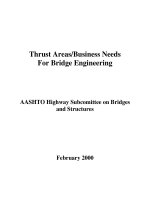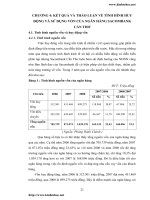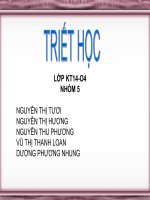Thảo luận về LRFD
Bạn đang xem bản rút gọn của tài liệu. Xem và tải ngay bản đầy đủ của tài liệu tại đây (50.86 KB, 16 trang )
Thrust Areas/Business Needs
For Bridge Engineering
AASHTO Highway Subcomittee on Bridges
and Structures
February 2000
i
INTRODUCTION 1
BRIDGE ENGINEERING THRUST/BUSINESS NEEDS DISCUSSIONS 3
Enhanced Materials, Structural Systems, and Technologies 3
Efficient Maintenance, Rehabilitation, and Construction 4
Bridge Management 5
Enhanced Specifications for Improved Structural Performance 6
Computer-Aided Design, Construction, and Maintenance 7
Leadership 8
APPENDIX A 9
Workshop Participants 10
APPENDIX B 11
Research Areas Complementing the AASHTO Thrusts/Business Needs 11
Enhanced Materials, Structural Systems, and Technologies 12
Efficient Maintenance, Rehabilitation, and Construction 12
Bridge Management 13
Enhanced Specifications for Improved Structural Performance 13
Computer-Aided Design, Construction, and Maintenance 14
1
INTRODUCTION
The Highway Subcommittee on Bridges and Structures (HSCOBS) of the American Association
of State Highway and Transportation Officials (AASHTO) has long recognized the benefit of
research in helping its members meet their responsibility to design and manage the nation’s
bridge infrastructure. Because of this recognition, HSCOBS strives to identify ways to fulfil the
business needs of its members, and, to that end, annually reviews research problem statements.
Some of these statements are recommended to the AASHTO Standing Committee on Research
(SCOR) for consideration for funding under the National Cooperative Highway Research
Program (NCHRP).
Because of this review and recommendation process, the subcommittee has obtained funding for
various NCHRP projects that have benefited the bridge community. Nevertheless, it has become
increasingly apparent to the subcommittee that a more structured procedure for prioritizing
research is needed. At its 1999 meeting, a resolution was approved supporting the development
of a strategic plan for bridge engineering research.
To provide essential input into a strategic plan, a steering committee, chaired by Mr. Malcolm
Kerley, Chairman of the Subcommittee’s T-11 Committee (Research), was established to plan a
workshop and select participants. The workshop was conducted February 14-16, 2000.
Participants included AASHTO State Bridge Engineers, the Federal Highway Administration
(FHWA), academics, consultants, and industry representatives (Appendix A lists the
participants). The information developed in the workshop is a consensus of the participating
bridge engineering professionals and will assist HSCOBS in identifying and giving priority to
the major themes for a coordinated national bridge engineering agenda. HSCOBS will use the
resulting agenda to evaluate and prioritize research problem suggestions to ensure a quality-
based research program aligned with HSCOBS’ needs.
The products of the workshop are the six “thrust” discussions provided in this report. Each
thrust focuses on a specific business need of the AASHTO bridge engineers. The unprioritized
thrusts are as follows:
• Enhanced Materials, Structural Systems, and Technologies;
• Efficient Maintenance, Rehabilitation, and Construction;
• Bridge Management;
• Enhanced Specifications for Improved Structural Performance;
• Computer-Aided Design, Construction, and Maintenance; and
• Leadership.
Each thrust discussion starts with a paragraph giving general background on the thrust. A brief
statement of the “business need” that would be satisfied with accomplishment of the thrust
follows. After listing the thrust’s objective, the thrust discussion concludes with a list of
“building blocks” (i.e., products or processes that must be available to satisfy the business need).
2
A list of research areas that complement the business needs of HSCOBS is provided in Appendix
B. This list is included solely to illustrate the range of researchable topics that are of interest to
bridge engineers.
This effort by HSCOBS is part of a broader effort by AASHTO and the Transportation Research
Board (TRB) to establish a national highway research agenda. This report will be of immediate
use to the Infrastructure Renewal working group of the National Research & Technology
Partnership Forum. TRB’s study for a Future Strategic Highway Research Program (F-SHRP)
will also benefit from the findings of this workshop.
This report is a working document. Thrusts and business needs are dynamic—they must be
continually reviewed and revised to reflect the ever-changing societal and technical environment
within which the highway system exists. HSCOBS is fully committed to the continued
maintenance and improvement of this document and to applying the contents to the identification
and prioritization of research.
3
BRIDGE ENGINEERING THRUST/BUSINESS NEEDS DISCUSSIONS
Enhanced Materials, Structural Systems, and Technologies
Bridges are subject to increasing traffic volumes and loads that degrade their long-term
performance and increase their maintenance needs. The combination of an aging infrastructure
and decreasing resources adds to the complexity of the problem. As the bridge community
maintains, rehabilitates, and replaces deficient structures and designs new structures to enhance
safety, mobility, and economic development, there is a growing need to use materials, structural
systems, and technologies that will provide longer service life with lower maintenance costs.
The business need is to develop and apply sustainable materials, products, structural systems,
and technologies that reduce life-cycle costs, extend useful life, and improve the constructability
of bridges. This effort will build on previous work in the area of high-performance materials,
durability research, and life-cycle cost. The development of new materials, structural systems,
and technologies will be encouraged. Increased emphasis must be given to overcoming barriers
to innovation.
Objective
To develop or enhance the following:
1. Materials that improve durability, reduce cost, and improve constructability;
2. Structural systems that improve performance and reliability;
3. Construction technologies that reduce construction or rehabilitation time and cost while
ensuring safety; and
4. Policies, procedures, and methodologies that enable the acceptance and adoption of new
technologies.
Building Blocks
1. Materials
High-strength, high-toughness, and durable steel plates and rolled sections.
High-performance concrete.
Fiber-reinforced polymers.
Corrosion protection systems for structural steel reinforcement, tendons, cables, and stays.
2. Structural Systems
Structural systems that span greater distances for less cost.
Self-maintaining bridge systems.
Modular construction.
Rapid replacement techniques.
3. Technologies
Training and certification programs for laboratory and field inspectors.
Test beds for evaluation of products and structural systems.
Deterioration models for life-cycle analyses.
Performance-based acceptance criteria.
Improved field welding processes.
4
Efficient Maintenance, Rehabilitation, and Construction
As the nation’s aging highway infrastructure experiences ever-increasing traffic volumes, more
efficient maintenance, rehabilitation, and construction technologies must be introduced.
Technological advances to increase work zone safety and to reduce construction time, costs, and
public inconvenience are essential. In addition, new products and processes are needed in order
to repair bridges so as to extend their useful lives. New products and procedures for preventive
maintenance also are needed.
The business need is to identify, develop and apply efficient technologies, processes, and
administrative methods that ensure quality and longevity, and enhance safety and that reduce
construction and maintenance time, costs, and effects on the public.
Objective
To reduce construction, maintenance, and rehabilitation time and expense through the following:
1. Efficient contracting methods,
2. Efficient construction methods, and
3. Efficient inspection and monitoring methods.
Building Blocks
1. Improved QA/QC specifications and inspection processes.
2. Design/build contracting.
3. Automated and integrated design, fabrication, and construction processes.
4. Best practices, methods, and models for preventive maintenance in order to optimize service
life.
5. Performance-based specifications.
6. Electronic design, fabrication, construction, and maintenance records.
7. Computer-aided design and drafting (CADD) automation for fabrication and inspection









